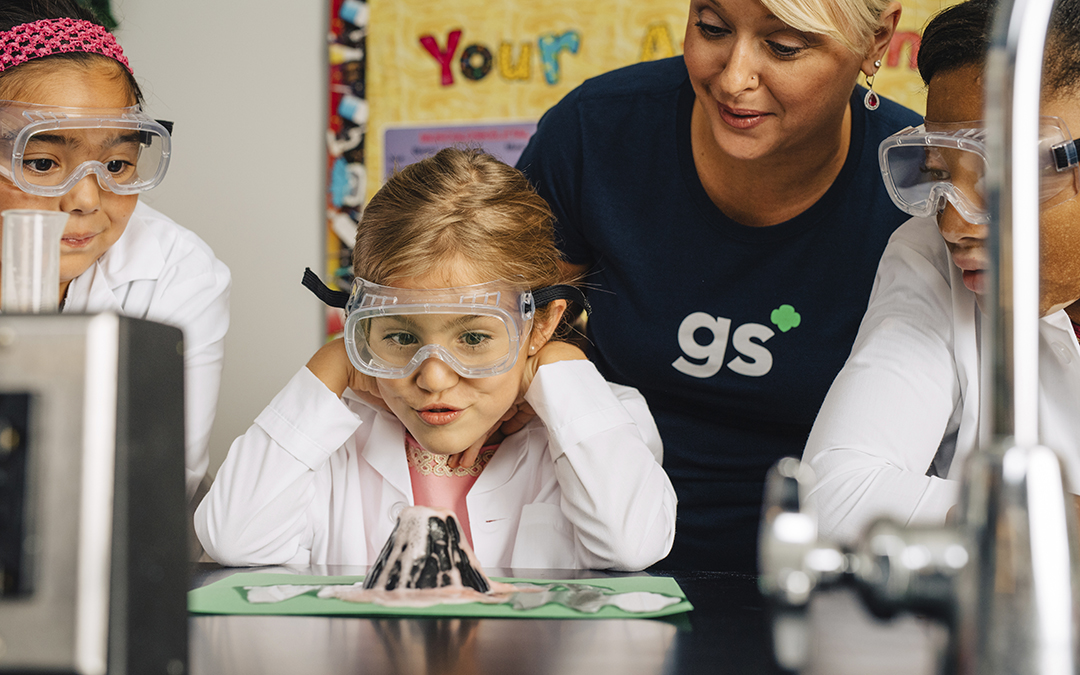Despite the ever growing demand for STEM professionals, there is still a significant gap between the number of men and women in science, technology, engineering, and mathematics fields. However, I’m excited that that gap is slowly closing, in part thanks to the work of Girl Scouts USA and their STEM Pledge, which works to increase the number of girls interested in and that may potentially pursue careers in STEM. As an Ambassador Girl Scout approaching the college admissions process, I have a possible major and interest in mind because of my exposure to STEM. This is my personal story of how I became interested in STEM, and how leaders, volunteers, and other older Girl Scouts can inspire other girls to explore the world of science, technology, engineering, and mathematics.
Save it for later!
Get Up Close and Personal
From as early as I can remember, I have always loved running and exploring the outdoors. I think that my elementary school also contributed to this love of nature—I still vividly remember my classrooms having all sorts of classroom pets, which helped me learn early on how to nurture and appreciate nature. In my kindergarten class, we had an odd and loveable group of classroom pets: a tarantula, walking stick, and goldfish. I learned how to help take care of and appreciate them all (even the tarantula!), and became fascinated with all of them, even the previously scary “creepy crawlies”. My teacher incorporated the pets into our science lessons, and taught us about the diet, lifestyle, and life-cycle of all of the pets. Even as I was barely learning to read and write, I learned to ask questions to explore the natural and scientific world around me through this experience. If you have younger Girl Scouts, badge activities around new critters or nature can spark interest and create some budding naturalists!
Hands-on Experimentation
In addition to my personal love of nature, I have also been exposed to an abundance of STEM-related projects throughout my education. From elementary school to my early years of high school, there were always fun science projects that made me excited to go to school every day. For science projects, the one that stayed with me was the “Biosphere Project”. The goal of the project was to create a self-sustaining environment in a soda bottle, as it represents our own ecosystem, planet Earth. In this project, all the basics of a biosphere such as water, soil, and living organisms such as plants, insects, and aquatic creatures. I had to research and learn about the relationships that various living organisms have to one another in order to thrive in a bottled biosphere. Through the 10 weeks of biosphere observation, I became knowledgeable about the germination rate and factors of plants, the carbon cycle, nitrogen-fixing bacteria, water turbidity, hydrological cycles, and more. Most importantly, I gained a greater perspective on the environment. Through creating the biosphere and observing it grow daily, I was amazed by how simple a biosphere can be, and how complex our planet is, with its large masses of land, bodies of water, and diverse organisms. Try out this bottle biosphere activity with your girls or a younger troop and watch the questions about our world roll in.
Be a STEM Role Model
Finally, I believe that the most important factor that inspired me to become interested in STEM is the many teachers, mentors, and Girl Scout leaders that I had growing up. All of these people around me were very knowledgeable and curious about the world around them. When they would share a topic or teach a new concept, I could see the genuine interest by the sparkle in their eyes and their enthusiastic manner, which made me interested as well. When thinking of them, I remember the advice that they all left me; never stop asking questions about the world. Although it is repeated over and over, it is the one piece of advice that I will carry with me for a long time, as it can be incorporated into any aspect of life. Encourage your girls to keep being curious about the world by helping them find answers to questions, modeling scientific curiosity and passion, and supporting their unique interests!
Because of the personal gratification that STEM has given me, I have been inspired to help my troop leaders motivate younger girls to try out STEM projects. My troop now has a club that focuses on creativity and robot-building. The club was easy to start, as companies such as LEGO have programs like FIRST Inspires with super valuable tips, resources, and event competitions to engage all learners of any age. The Juniors and Cadettes in my troop are part of the FIRST LEGO League Program (ages 11–18). Already, I’ve witnessed them building life-long skills in confidence, creativity, communication, leadership, and teamwork under the support of their mentors, troop leaders, and older Girl Scouts. The best part for me as an older Girl Scout is seeing the excitement on their faces when the younger girls find solutions to different robotics challenges. After a year of problem-solving, the girls created a robot that could follow a planned route, and they were able to enter the LEGO competition at the end of the year. More and more younger girls now want to participate in the same activities after seeing how much fun the older girls were having. Our troop currently plans to incorporate the FIRST LEGO (ages 6–10) League Junior Program to introduce our younger Girl Scouts to STEM subjects.
After hearing my story and how my troop incorporated STEM-learning clubs, I also hope that your troop can be inspired to make your own club or try out some of the related activities. This way, you can give girls a chance in STEM and encourage them to always ask the questions that the world needs.
What to do next:
- Whether you’re ready to start bringing STEM into your meetings, or new to the world of STEM, check out our other STEM-themed blog posts on The Trailhead!
- Girl Scouts are citizen scientists, programmers, inventors, and more—and Girl Scout STEM Programs support them in all their new endeavors. Check out all the new STEM badges available on the Badge and Award Explorer!
- Dr. Andrea Marshall isn’t just the Queen of Manta Rays, having helped save one species and discovered another—she’s also a former Girl Scouts! Read more about her amazing career and advice for Girl Scouts exploring careers in science.


